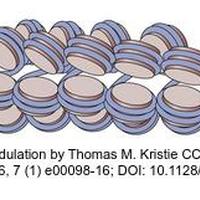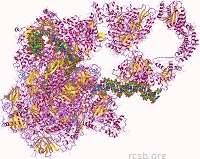Topic 7: Nucleic acids HL 
This page contains multiple choice questions in the style of Paper 1 of the Biology exams.
They test the breadth of your knowledge of the understandings and skills about the Nucleic acids HL topic.
To spend more time reviewing the topic before answering these questions, use the revision resources.
Nucleic acids HL revision resources
This is an introduction to the HL Nucleic acids topic. It lists understandings and skills expected for Topic 7 including; extra details of DNA structure and replication, transcription and gene expression as well as translation. Helpful for...
Learn from any mistakes. Every question has an examiner's explanation that appears when you check your answers.
It is estimated that a large percentage of human DNA is 'non-coding'.
Which of the following answers lists important functions of these non-coding regions?
Hidden explanation (optional)
- Non-coding regions of DNA have other important functions, limited to regulators of gene expression, introns, telomeres and genes for tRNAs.
Which of the following is a role of nucleosomes in eukaryotes?
Supercoiling of DNA involves many steps, but the formation of nucleosomes is an impotant part of this. DNA is wrapped two times around a group of histone proteins.
Also: Transcription is partly regulated by Nucleosomes in eukaryotes.
To which part of an RNA primer can DNA polymerase III enzymes add nucleotides?
DNA polymerase enzymes can only add nucleotides to the 3’ end of a primer.
Which is the best description of 'crossing-over'
- DNA replication makes a second chromatid in each chromosome in interphase before meiosis.
- Crossing over exchanges pieces of DNA between non-sister homologous chromatids and forms new combinations of alleles on the chromosomes formed in meiosis.
RNA polymerase adds an RNA nucleotide to a growing mRNA molecule during transcription.
In which direction does this happen?
The direction of Transcription is in a 5’ to 3’ direction as RNA polymerase adds the 5´ end (phosphate) of the free RNA nucleotide to the 3´ end of the growing mRNA molecule.
In research geneticists were able to compare methylation in genes thought to be linked with drought tolerance in rice. This graphs shows the methylation levels found.

What can be concluded from this data about the correlation between methylation patterns and drought tolerance?
The skill to analyse changes in the DNA methylation patterns in connection with gene expression.
The diagram shows the general principal that more methylation is found in the drought tolerant rice.
There is no evidence that this is the cause, nor which genes are specifically involved.
How did Hershey and Chase label protein and DNA in bacteriophages to demonstrate that DNA was the genetic material?
Phosphorus is not present in protein and sulphur is not present in DNA so these elements can be sure to label just one of the molecules.
Nitrogen is present in both DNA and protein.
Which of the following bonds are found in a DNA double helix?
I Covalent bonds between sugar and sugar.
II Hydrogen bonds.
III Covalent bonds between phosphate and sugar.
IV Peptide bonds.
There are hydrogen bonds between the bases of opposing DNA strands and covalent phosphodiester bonds joining the phosphate on the 5' carbon of the sugar to the 3' Carbon of the sugar in the growing DNA strand. This makes a sugar phosphate backbone.
Which enzyme attaches RNA nucleotides at the start of DNA replication?
RNA Primase provides the starting point for replication, helicase unwinds the double helix, DNA ligase joins Okazaki fragments and DNA polymerase I removes RNA primers and replaces them with DNA
Which best describes the nature and direction of DNA replication on the lagging strand?
On the lagging strand, replication is discontinuous and away from the replication fork.
In which direction does DNA replication occur on the leading strand?
DNA polymerase III adds nucleotides in a 5' to 3' direction. In the case of the leading strand, this is towards the replication fork.
Why must DNA polymerase III replicate the leading and lagging strands of DNA in opposite directions?
Enzymes are specific and the active site of DNA polymerase III can only bind to the 5; end of the backbone. As the strands are antiparallel this will be in opposite directions.
What is a promoter gene?
A promoter gene is a sequence of DNA found near the beginning of a gene that controls gene expression.
Which enzyme binds to a promoter gene?
RNA polymerase binds at the promoter gene to begin transcription of mRNA.
Which structures are possessed by all protein molecules?
All proteins possess a primary structure of the amino acid sequence and a secondary structure of a-helix or b pleated sheet and a tertiary three dimensional shape but some proteins do not have multiple polypeptide subunits (quaternary).
What is a conjugated protein?
Prosthetic groups such as Iron in hemoglobin are part of the functional region of proteins. and are held in place by the tertiary structure.
How can a cell increase the rate of protein production?
Promoter genes can cause production of greater quantities of mRNA for translation.
Polysomes allow more than one polypeptide chain to be produced from one mRNA molecule.
What is the sequence of events in the assembly of a ribosome at the start of transcription?
The small subunit of the ribosome has a binding site for mRNA, when the mRNA binds to this site, the large subunit attaches.
Which enzyme breaks the hydrogen bonds between nucleotides. unwinding the DNA helix for transcription?

RNA polymerase unwinds the DNA double helix, breaking the hydrogen bonds (and also forms the mRNA strand). The other enzymes are involved in DNA replication.
Why are enzymes not directly involved in protein synthesis by the ribosome?
rRNA is the only non-protein known to have catalytic properties. ATP is required for polypeptide bond formation but the ribosome catalyses the formation of the peptide bond.
Refresh this page to try a new set of 20 multiple choice questions. The questions will be different next time you visit. Great revision.
How much of Topic 7 Nucleic acids HL Paper 1 questions have you understood?


 Twitter
Twitter  Facebook
Facebook  LinkedIn
LinkedIn